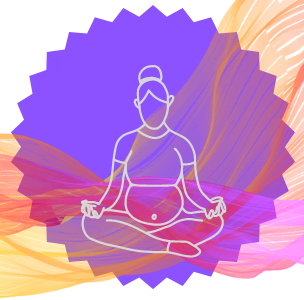I wish I’d known more about this technique to set myself up for my past labors and to possibly help when one of them stalled at 8-9 cm dilation! The Forward Leaning Inversion, a Spinning Babies technique, is not only recommended to use for breech babies, which is what I used to think, but also to potentially establish a fetal position that may help labors progress more smoothly and quickly.
My first labor had a fairly smooth labor progression up until I reached 8 cm. It began around midnight, and by around 3 pm the next day, my midwife was measuring that I was 9 cm with a bit of a “lip” left on one side of my cervix. I had been moving around since labor began in positions that I often recommend, like an all 4s table position while circling my hips, child’s pose in between contractions when I was tired, and I spent much time in my birthing tub once I reached about 5 cm of dilation. I was encouraged to try squatting over the toilet during contractions to see if that “lip” would fully dilate. After several hours of trying this and being in excruciating pain. I decided to go to the hospital for an epidural. On my way to the hospital, I closed back up to 8 cm. Who really knows if trying more Forward Leaning inversions prior to labor would have set me up for a more balancing opening of my cervix, or if trying it once this stall began would have resolved the “lip,” but I do wish it had been a technique in my toolbag to at least consider. I think the toilet posture was a great suggestion by my midwife that would have been more successful along with the Forward Leaning Inversion and the Side Lying Release. This article is only about the Forward Leaning Inversion, but I also know now that I probably had a pelvic floor imbalance (tighter on one side) that the Side Lying Release from Spinning Babies could have also helped break this stall or prevent it. Read more about the Spinning Babies Forward Leaning Inversion below, source website at the end.
Below info taken directly from Spinning Babies website – see website for instructions for how to safely practice & to see list of contraindications.
The Forward Leaning Inversion posture from Spinning Babies, put simply, is a technique that creates room in the lower uterus. The baby can then use that space—with the natural pull of gravity—to snuggle into a more ideal position for birth. The Forward-leaning Inversion technique comes from Dr. Carol Phillips, DC who teaches Dynamic Body Balancing.
The Forward-leaning Inversion potentially makes room for a good fetal position by untwisting any ligaments to the lower uterus and cervix that may be wound up from sudden stops or a twisted posture.
Kneeling afterward also allows temporarily lengthened ligaments to align the uterus with the pelvis. The cervix may become less tipped or tight and then be able to let the baby’s head position better, and the cervix to dilate in labor more easily.
This technique may also reduce back pain, hip pain, or tailbone pain. Improved fetal positioning does occur too. It is a very worthwhile activity because simply turning the baby’s head down is a notable achievement in and of itself.
When to NOT do it:
- If medical contraindications exist for going upside down, such as high blood pressure or another risk of stroke
- If you have heartburn, glaucoma, or hypertension
- In cases where amniotic fluid levels are unusually large and the doctors are worried and measuring weekly
- If you have a sinus infection and going upside down is especially uncomfortable
- Right after eating, to avoid potential heartburn
- If there is a suspected or known problem with the placenta in pregnancy, including bleeding
- If you have uterine pain of an undetermined origin. If this is the case, get assessed immediately
- If the baby is having, or has had, frantic vigorous movements. Be sure to have the baby assessed immediately
- If the inversion causes unexpected pain. (Remember, your head may pound a bit for the first few times, but that’s normal.) A severe headache should be evaluated by a physician immediately
- If your labor is progressing normally. Enjoy your labor
- If there has been abundant fluid in labor and the baby is high at -2 station or above, and the water has released with the baby’s head high (in which case, open the pelvic brim with Walcher’s or a variation of Walcher’s)
- If you simply don’t feel that this is right for you (always trust the mother’s intuition and respect her choice)
Before practicing this technique, read all about it at: https://www.spinningbabies.com/pregnancy-birth/techniques/forward-leaning-inversion/







